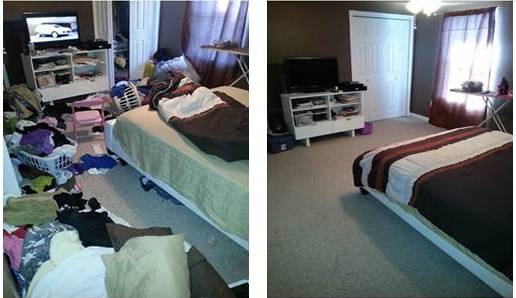CONTROL PART I
Pre-Treatment Preparations
Preparation of a living area for bed bug elimination should focus on containment of the infestation through cleaning, organizing, repairs, and physical barriers. Do everything possible to avoid spreading bed bugs to new locations.
The following, in order, will increase your chance for complete bed bug control:
- A reduction of clutter
- Physical removal of bed bugs and eggs using a vacuum.
- Isolation of the bed using barriers, such as mattress encasements, sticky barriers, or interceptors
- The elimination of bed bug hiding spots
- Use of a combination of chemical and non-chemical methods to eliminate a bed bug infestation
The key to bed bug control is being thorough and systematic in your approach. Incomplete remediations are typically the result of only one method being used or half-measures taken. Remember, bed bugs are resilient pests and can reproduce rapidly. If some are missed during your control efforts, it won't take long for them to reestablish themselves. For most, the tolerance threshold for bed bugs, described in the Integrated Pest Management principles, is ZERO and that does take work and a commitment to be bed bug free.
Reducing Clutter by Cleaning and Organizing a Room or Home
Cleaning and organizing a room or home for bed bug management can be as burdensome as moving. It is, however, an extremely important first step to control bed bugs, because bed bugs will thrive in a cluttered living area.
Vacuuming and cleaning should be done before chemical or non-chemical treatment.
Cleaning should be carried out in a systematic way, beginning with removing items from the infested room or home. Soap or detergent will aid in the clean up of bed bug debris and allergens, making the environment healthier and more tolerable for those living there.
Steps to follow include:
- Scan the room for items on the floor. Make a plan for each item, and how it will be quarantined (closed into a plastic bag, for example), inspected, sanitized of bed bugs, and stored until further notice.
- Place clothes, shoes, plush toys, pillows, and bedding into large clear plastic bags and seal them tightly to be laundered.
- Empty furniture items for better inspection
- Plastic tote bins that have an airtight seal can be used for items that cannot be laundered, such as hard toys, electronics, books, breakable items, etc. Be prepared to store these items for a period of time until they can be thoroughly inspected or enough time has passed that bed bugs are dead – at least a year.
- Launder all clothing and bedding (it is recommended to use the highest heat settings for washing and drying if possible)
- Move furniture away from walls
BEFORE AFTER

(For demonstration purposes only)
Vacuuming
After removing clutter and organizing the room, it's time to vacuum, using a HEPA-equipped vacuum. A regular vacuum is acceptable, however, a HEPA-equipped vacuum will reduce the spread of allergens. A crevice tool will be needed to focus suction in small spaces, cracks and crevices.
Steps to follow include:
- Once the room has been "stripped" of all personal belongings, begin vacuuming the bed, paying special attention to the mattress seams.
- Use a brush or crevice attachment with a scraping motion to dislodge bed bugs or eggs.
- Remove the mattress and box spring from the bed frame and inspect and vacuum all surfaces, removing all loose debris and visible bed bugs.
- Flip the bed frame over and vacuum any crevices where bed bugs may hide. This is especially important for wooden bed frames.
- Vacuum inside and under drawers of night stands, dressers, and other furniture.
- Turn over each piece of furniture and vacuum the under side of each.
- Pay attention to screw and nail holes.
- Vacuum along the bottoms of all walls and the moldings. If molding or wallpaper is loose, lift or remove and vacuum underneath.
- Make sure to vacuum around heating units.
- Vacuum along carpet edges.
- Vacuum plush furniture with a carpet-beater attachment or by patting the furniture while vacuuming to flush out bed bugs.
- If a vacuum brush attachment is used it is possible some live bugs or eggs could be caught in the brush bristles. Wash the vacuum brush with hot water and detergent if this is a concern.
Sources:
Michigan Manual for the Prevention and Control of Bed Bugs
United States Environmental Protection Agency
